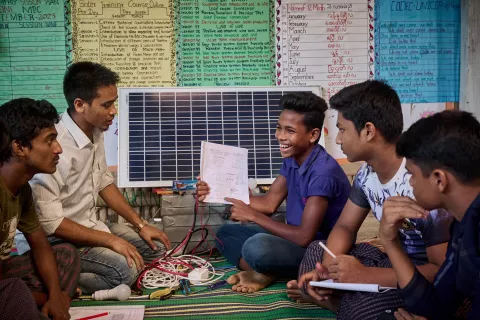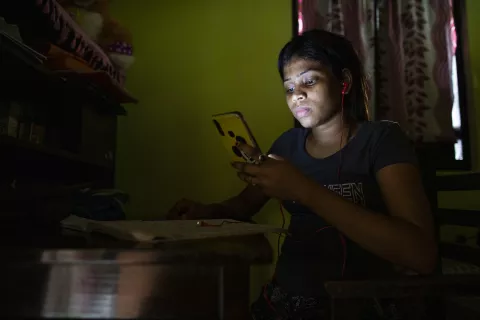How school closures changed my life
From 4 children in South Asia who’ve lived through them

It’s been two years since schools first closed in South Asia.
When they did, 434 million children not only lost their place to learn, but relationships and support networks — just as the world was turning upside down.
Millions also lost their only place to eat a nutritious meal, access medical care and their place of safety.
Girls lost a place that can keep them safe from child marriage and pregnancy.
Research is just starting to reveal the terrible toll of school closures on children’s learning and wellbeing — and how these impacts could last their lifetimes. But children's own experiences during the pandemic have remained hidden.
They’ve struggled in isolation and often silence.
Two years on, four children from South Asia tell us how school closures have changed their lives.
“I used to study in a school before the lockdown. When the lockdown started, my family had to leave for the village. My father was also sick. So, I had to start working again to support my family,”

Before the pandemic hit, Imran’s family were surviving on a few dollars a day. His mother, Marufa worked as a domestic helper and his father, Suleiman, was a rickshaw puller. Imran worked part-time after school, in a paper recycling shop, to help.
But when lockdowns hit, his family, like millions in South Asia, watched their means of income dry up overnight.
The family moved back to their small shelter in the village of Netrokona, five hours north of Bangladesh’s capital, Dhaka. But without any land to farm, they struggled to earn a livelihood there either.
With no school to attend, his father unwell and the family facing financial crisis, Imran felt duty bound to help.
He returned to the capital alone and restarted work in the paper recycling shop — full-time.
His work involves folding paper and making the small paper bags used widely across the country in grocery shops.
“I start at 9 am and work till 10 pm. I don’t like working even though everyone there treats me very well. There are no other kids my age at this shop.”
When the shop also closed during lockdowns, Imran was helped to enrol in a UNICEF supported Child Protection Hub, ran by a special social worker named Azad.
“I started going to Azad bhai. They provided me with three meals a day and I sometimes slept there too.”
At the hub, Imran was also able to access healthcare and well-being services — and Azad was even able to arrange a visit from Imran’s family, whom he’d been missing terribly.
“I started feeling really sad and dejected. I kept asking the social worker to take me to my parents. Azad bhai took me back to Netrokona. My parents were very surprised to see me and started hugging me.”
When the lockdown ended the whole family was able to move back to Dhaka.
But with schools closed, Imran continued to work long hours at the recycling shop to support his family. He gets paid $35 a month, which he gives to his mother.
“If I can study, I will get a better job and take care of my parents...I want to keep my parents happy when I grow up.”

***

“In our country, the pandemic has had the biggest impact on girls' education. COVID-19 literally halted all progress and work.”
Mahnoor, from a village in rural Balochistan, Pakistan was 14 when the pandemic hit.
She’d always been an advocate for girls’ education, but when schools closed, she saw children in her village stop learning completely.
“We don’t have teachers in our village. I saw that the girls especially were not getting education. Their time was going to waste.”
Before COVID-19, over 12 million girls in Pakistan (ages 5 to 16) were out-of-school. When classrooms closed, Mahnoor knew the longer they stayed closed, the more likely girls would never return.
She decided to take matters into her own hands.
“I want to educate kids especially girls. I set up a centre at home, with the help of my parents, and started teaching children there. The children were so happy to come and learn.”

At Mahnoor’s centre children learnt about staying safe from COVID-19 and the girls got together to learn. But Mahnoor says the biggest challenge is changing mindsets towards girls' education.
“My parents have always supported my education. But attitudes towards girls’ education aren’t always positive and not enough importance is given to girls’ education.”
Mahnoor believes that one of the biggest factors stopping girls from accessing education is a lack of learning facilities for girls in rural areas.
“The girls' school is 20 kilometres away. Girls can’t go that far alone.”
“Even if there are schools for girls, then there are no facilities in the school. There are no washrooms in the school. Boys go to the field. Where do girls go?”
Mahnoor tells us that her goal is to give importance to girls' education in her area. She wants to make parents aware of the importance of children continuing to learn — especially when schools close or learning is interrupted.
“I have big dreams. This world can become a better place. The best way is to get your kids educated.”

***

“We have many primary and secondary schools that are doing a fantastic job in educating the students. But not me. I’m a so-called special student with special needs. I’m blind and the system is not ready for me.”
Zayaa from Male, Maldives, is one of the 64.4 million children in South Asia with a disability. For children with disabilities, the impacts of the pandemic have been particularly disproportionate.
Before COVID-19, children with disabilities already faced barriers when trying to access their education. Schools across the region lack disability-friendly infrastructure, making it difficult for children with disabilities to get around.
But when schools closed and classes switched online, students with disabilities found that they had been overlooked — again.
Most digital learning content and platforms failed to cater for them. For vast numbers of children with disabilities, including visual impairments like Zaaya, this made it impossible to continue learning.
As highlighted in a recent UNICEF report in Maldives, children with disabilities fall behind their peers without disabilities — and this was before COVID-19.
Zayaa isn’t waiting for new research. Through youth consultations facilitated by UNICEF, she’s urging governments to make education inclusive for all, including adolescents and children with disabilities.
“We — the young people of South Asia, have dreams and hopes of a better world.”
***

“I understand the lessons better in school when our teachers explain. I don’t understand much when I watch it on TV.”
Dechen wants to become a teacher when she’s older.
She’s also one of about 17,000 students in Bhutan and 147 million in South Asia, who struggled through school closures without access to a TV, computer, smartphone or internet at home.
But that’s not stopped her from trying to learn.
For much of school closures, she’s studied at her classmate and neighbour’s house, Pema — whose family owns a TV where she can watch lessons and a smartphone to access Google Classroom where she complete assignments.
“I wait for her to complete her homework first. Then I work on mine.”
Tragically, the evidence shows that remote learning has been no substitute for being at school — and the children with the least, like Dechen, have lost out most in their learning.
School closures in South Asia have forced hundreds of millions of children and their teachers to transition to remote learning in a region with low connectivity and device affordability.
Even when a family has access to technology, children are not always able to access it. As a result, children have suffered enormous setbacks in their learning journey.
They’ve also lost the most from the relationships and life school provides.
“I don’t understand much when I watch it on TV. At school, the teacher explains until we understand the lessons but on television, the lessons go very fast and we can’t catch up.”

“I don’t like staying home. At school, we play and study. At home, we cannot go anywhere. I miss my school, my teachers and my friends.”
Children have lost so much in the last two years.
But every child is different. And their experiences during school closures have been different too.
As schools start to reopen in South Asia (once again), we must support teachers and parents to get every child back in the classroom and back on track.
We urge governments to invest especially in the children who have lost the most — so they can return to school, recover their learning & reclaim their futures too.



